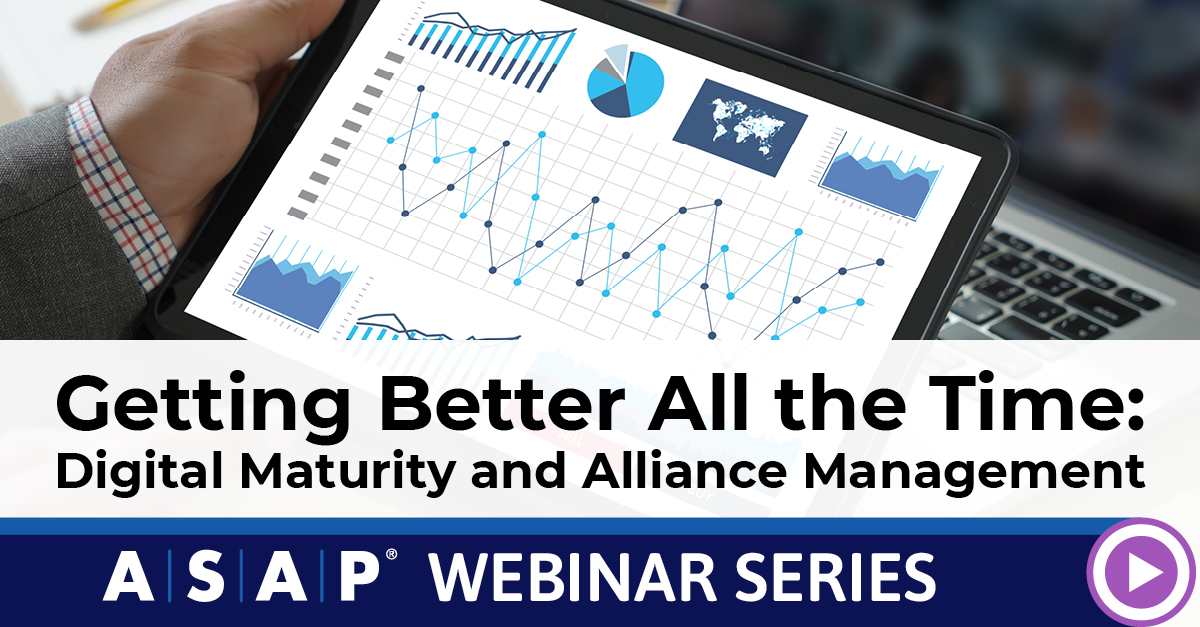Getting Better All the Time: Digital Maturity and Alliance Management
Alliance professionals may lead their peers from other business functions in many things—communication, relationship building, connecting with partners, and convening key stakeholders and decision makers, among others—but one area where they sadly remain laggards is digital maturity. This has a number of implications, ranging from excessive time spent manually and laboriously updating spreadsheets to inefficient overfocus on administrative tasks to the glaring lack of a common repository for alliance information.
Ever resourceful, for some time now alliance managers have found various ways to muddle through this state of affairs, many of them suboptimal, but there may be a digital light dawning at the end of their long dark night. That ray of sunshine appeared in a recent ASAP webinar, “How Digitization Will Help Improve Your 2022 Alliance Practice,” presented by Louis Rinfret and Michael Roch of allianceboard.
Rinfret and Roch have been busy recently compiling their ongoing Digital Alliance Management Maturity Index, which surveys and measures the state of digital maturity in alliance management across industries and companies. They said that while there’s still a long way to go, they have to admit it’s getting better all the time.
Don’t Get Lost in Repetitive Tasks
In their presentation, Rinfret and Roch sought to illuminate why digital maturity matters—or should matter—to alliance professionals, the ways it can increase the efficiency of how they spend their time, and thus how it can enhance their effectiveness at what they do best: move alliances toward more value creation and away from value-eroding risks. In addition, the two allianceboard leaders laid out five ways in which digitization can make alliance management better.
Formed in 2015, allianceboard has created a software platform with the express purpose of helping alliance managers track, organize, and grow their alliances and ecosystems. The company has offices in Montreal, Zurich, and Tallinn, Estonia, and since its founding has formed partnerships and client relationships across industries such as biopharma, high tech, services, and energy. (It also has a partnership with ASAP as of 2020.)
Roch, who is allianceboard’s chief commercial officer, noted that alliances often begin with good intentions and to great fanfare, but once the excitement of the launch dies down, “people are kind of lost.” As alliance teams become increasingly mired in repetitive clerical tasks and more project-oriented duties, something is missed: specifically, the opportunity to create value.
"The key over time is to reduce the proportion of time spent on these repetitive tasks and move to more high-value tasks,” Roch said.
Alliance Managers Must Seize the Day—and Capture the Value
Time spent manually updating spreadsheets, reports, or proprietary “in-house solutions” is time taken away from alliance professionals’ better selves: playing their strategic role, helping their organizations by enabling what allianceboard founder and CEO Rinfret called “strategic agility, operational excellence, and other C-suite imperatives.”
In fact, findings from allianceboard’s Digital Alliance Management Maturity Index show that overall partnering capacity married to alliance management digital infrastructure leads to greater value realization from alliances, as well as the strategic agility, operational efficiency, and risk management to which Rinfret alluded.
In order to realize an appropriate return on investment in alliances, alliance managers must seize opportunities and minimize risks, Rinfret emphasizes. Too much time spent on administrative tasks or keeping internal stakeholders updated gets in the way. In addition, as Roch mentioned, organizational turnover coupled with the lack of a central data and information platform means a highly inefficient onboarding process for new alliance team and committee members.
None of that is good news for alliance managers seeking to add value and raise the profile of their alliances.
Translation: Better Together, in Five Ways
“Digitization can’t solve all of that, but it can make it better,” Roch said. “It can help new members be effective right out of the box. The question is, how do we translate this to practical things? How can digital infrastructure help us be better partners? How can digital transformation help us to be more efficient so we can eventually be more effective and be partners of choice?”
How indeed? According to Roch, having a central platform or source of alliance information helps not only to track and organize information but to de-risk the alliance management operation, helping alliance professionals move from being reactive to proactive and allowing for real-time collaboration with their partners, not just file sharing.
“What is the global trajectory of my alliance ecosystem?” Roch continued. “What is the path, how big is the pipeline? It takes us from just organizing things to optimizing what we’re doing.”
As for the five ways digital maturity can help alliance managers get better all the time, Rinfret and Roch offered these:
- Centralizing everything in one platform to relieve alliance professionals from deadly operational and repetitive tasks.
- Keeping the focus on high-impact activities, such as managing senior stakeholders, resolving internal issues, and advocating with and for partners.
- Providing meaningful reports instantly.
- Developing a high-impact dialogue with senior stakeholders via analytics, data, and dashboards.
- Onboarding new alliance team members better, faster, cheaper, smoother.
Quantum of Solace: Functions Come in Waves
So why has alliance management lagged behind other functions in digital maturity? From his 20-some years of research into alliances, Rinfret had an answer.
“Nobody really gets what alliance managers do except alliance managers,” Rinfret said. “Many people are not too clear about it, so it’s no surprise that there are no systems” to track and organize alliances.
"Functions come in waves,” added Roch, outlining a progression in which sales, marketing, and human resources have all had their day in the sun. “Alliance management is a somewhat younger function, but it’s coming into its time. It’s a very exciting journey.”


